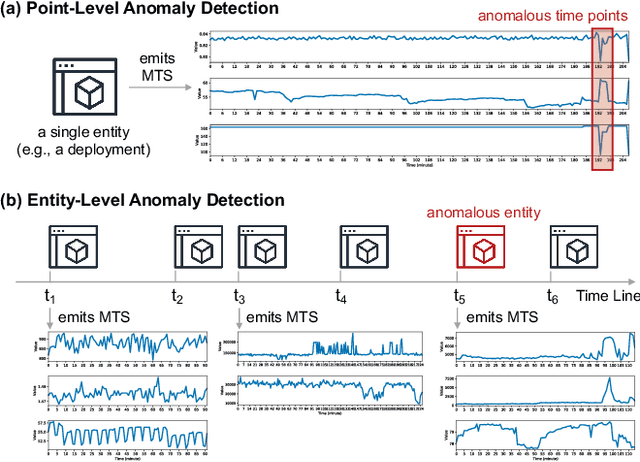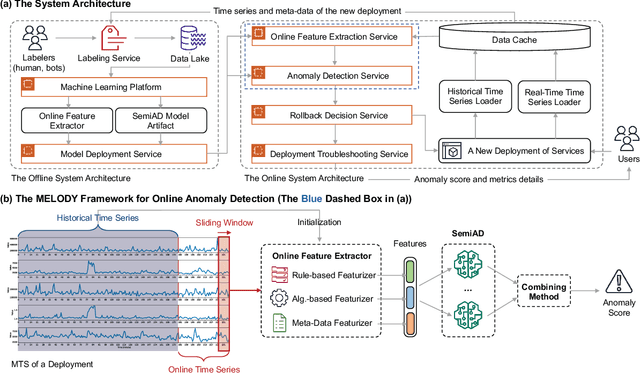Peihong Jiang
MELODY: Robust Semi-Supervised Hybrid Model for Entity-Level Online Anomaly Detection with Multivariate Time Series
Jan 18, 2024



Abstract:In large IT systems, software deployment is a crucial process in online services as their code is regularly updated. However, a faulty code change may degrade the target service's performance and cause cascading outages in downstream services. Thus, software deployments should be comprehensively monitored, and their anomalies should be detected timely. In this paper, we study the problem of anomaly detection for deployments. We begin by identifying the challenges unique to this anomaly detection problem, which is at entity-level (e.g., deployments), relative to the more typical problem of anomaly detection in multivariate time series (MTS). The unique challenges include the heterogeneity of deployments, the low latency tolerance, the ambiguous anomaly definition, and the limited supervision. To address them, we propose a novel framework, semi-supervised hybrid Model for Entity-Level Online Detection of anomalY (MELODY). MELODY first transforms the MTS of different entities to the same feature space by an online feature extractor, then uses a newly proposed semi-supervised deep one-class model for detecting anomalous entities. We evaluated MELODY on real data of cloud services with 1.2M+ time series. The relative F1 score improvement of MELODY over the state-of-the-art methods ranges from 7.6% to 56.5%. The user evaluation suggests MELODY is suitable for monitoring deployments in large online systems.
SpectraNet: Multivariate Forecasting and Imputation under Distribution Shifts and Missing Data
Oct 25, 2022Abstract:In this work, we tackle two widespread challenges in real applications for time-series forecasting that have been largely understudied: distribution shifts and missing data. We propose SpectraNet, a novel multivariate time-series forecasting model that dynamically infers a latent space spectral decomposition to capture current temporal dynamics and correlations on the recent observed history. A Convolution Neural Network maps the learned representation by sequentially mixing its components and refining the output. Our proposed approach can simultaneously produce forecasts and interpolate past observations and can, therefore, greatly simplify production systems by unifying imputation and forecasting tasks into a single model. SpectraNet achieves SoTA performance simultaneously on both tasks on five benchmark datasets, compared to forecasting and imputation models, with up to 92% fewer parameters and comparable training times. On settings with up to 80% missing data, SpectraNet has average performance improvements of almost 50% over the second-best alternative. Our code is available at https://github.com/cchallu/spectranet.
Deep Generative model with Hierarchical Latent Factors for Time Series Anomaly Detection
Feb 25, 2022



Abstract:Multivariate time series anomaly detection has become an active area of research in recent years, with Deep Learning models outperforming previous approaches on benchmark datasets. Among reconstruction-based models, most previous work has focused on Variational Autoencoders and Generative Adversarial Networks. This work presents DGHL, a new family of generative models for time series anomaly detection, trained by maximizing the observed likelihood by posterior sampling and alternating back-propagation. A top-down Convolution Network maps a novel hierarchical latent space to time series windows, exploiting temporal dynamics to encode information efficiently. Despite relying on posterior sampling, it is computationally more efficient than current approaches, with up to 10x shorter training times than RNN based models. Our method outperformed current state-of-the-art models on four popular benchmark datasets. Finally, DGHL is robust to variable features between entities and accurate even with large proportions of missing values, settings with increasing relevance with the advent of IoT. We demonstrate the superior robustness of DGHL with novel occlusion experiments in this literature. Our code is available at https://github.com/cchallu/dghl.
Value-Added Chemical Discovery Using Reinforcement Learning
Nov 10, 2019


Abstract:Computer-assisted synthesis planning aims to help chemists find better reaction pathways faster. Finding viable and short pathways from sugar molecules to value-added chemicals can be modeled as a retrosynthesis planning problem with a catalyst allowed. This is a crucial step in efficient biomass conversion. The traditional computational chemistry approach to identifying possible reaction pathways involves computing the reaction energies of hundreds of intermediates, which is a critical bottleneck in silico reaction discovery. Deep reinforcement learning has shown in other domains that a well-trained agent with little or no prior human knowledge can surpass human performance. While some effort has been made to adapt machine learning techniques to the retrosynthesis planning problem, value-added chemical discovery presents unique challenges. Specifically, the reaction can occur in several different sites in a molecule, a subtle case that has never been treated in previous works. With a more versatile formulation of the problem as a Markov decision process, we address the problem using deep reinforcement learning techniques and present promising preliminary results.
 Add to Chrome
Add to Chrome Add to Firefox
Add to Firefox Add to Edge
Add to Edge